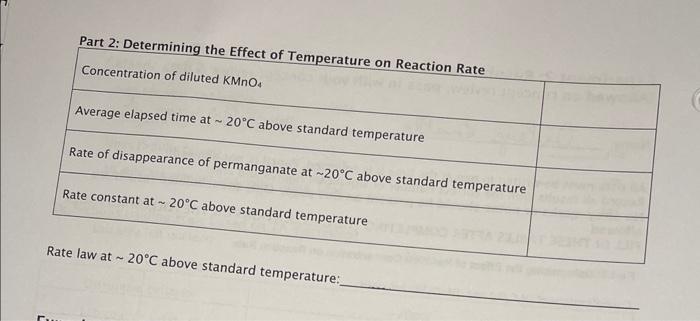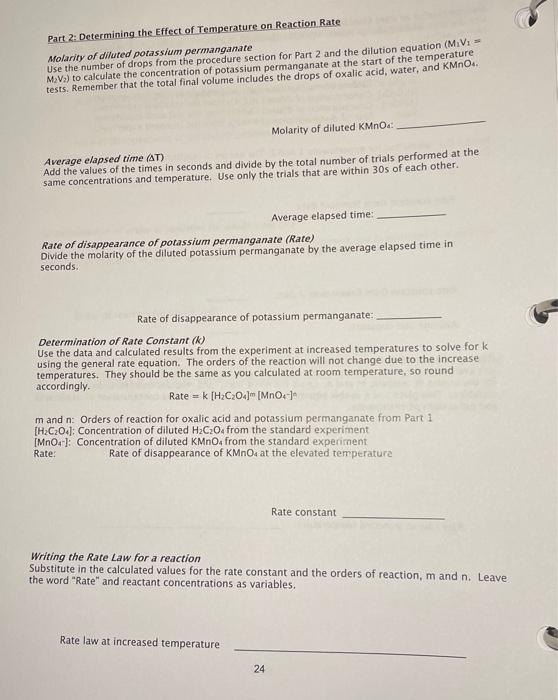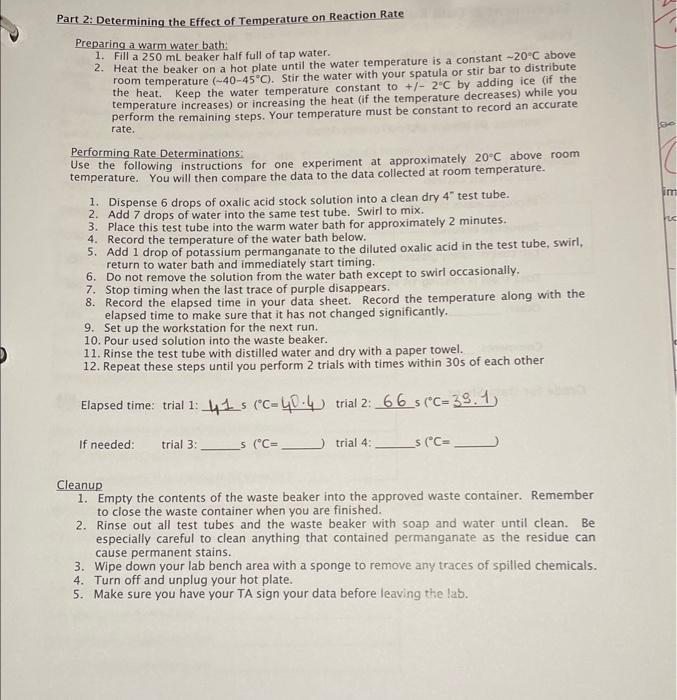Answered step by step
Verified Expert Solution
Question
1 Approved Answer
need help with this please Part 2: Determining the Effect of Temperature on Reaction Rate Concentration of diluted KMnO4 Average elapsed time at 20C above
need help with this please 


Part 2: Determining the Effect of Temperature on Reaction Rate Concentration of diluted KMnO4 Average elapsed time at 20C above standard temperature Rate of disappearance of permanganate at 20C above standard temperature Rate constant at 20C above standard temperature Rate law at 20C above standard temperature: Part 2: Determining the Effect of Temperature on Reaction Rate Molarity of diluted potassium permanganate Use the number of drops from the procedure section for Part 2 and the dilution equation (M1V1= M2V2 ) to calculate the concentration of potassium permanganate at the start of the temperature tests. Remember that the total final volume includes the drops of oxalic acid, water, and KMnO. Average elapsed time ( T T) Add the values of the times in seconds and divide by the total number of trials performed at the same concentrations and temperature. Use only the trials that are within 30 of each other. Average elapsed time: Rate of disappearance of potassium permanganate (Rate) Divide the molarity of the diluted potassium permanganate by the average elapsed time in seconds. Rate of disappearance of potassium permanganate: Determination of Rate Constant (k) Use the data and calculated results from the experiment at increased temperatures to solve for k using the general rate equation. The orders of the reaction will not change due to the increase temperatures. They should be the same as you calculated at room temperature, so round accordingly. Rate=k[H2C2O4]m[MnO4]a m and n : Orders of reaction for oxalic acid and potassium permanganate from Rart I [ H2C2O4 ]: Concentration of diluted H2C2O4 from the standard experiment. [ MnO41 : Concentration of diluted KMnO4 from the standard experiment Rate: Rate of disappearance of KMnO4 at the elevated temperature Rate constant Writing the Rate Law for a reaction Substitute in the calculated values for the rate constant and the orders of reaction, m and n. Leave the word "Rate" and reactant concentrations as variables. Rate law at increased temperature 24 Part 2: Determining the Effect of Temperature on Reaction Rate Preparing a warm water bath: 1. Fill a 250mL beaker half full of tap water. 2. Heat the beaker on a hot plate until the water temperature is a constant 20C above room temperature (4045C. Stir the water with your spatula or stir bar to distribute the heat. Keep the water temperature constant to +12C by adding ice (if the temperature increases) or increasing the heat (if the temperature decreases) while you perform the remaining steps. Your temperature must be constant to record an accurate rate. Performing Rate Determinations: Use the following instructions for one experiment at approximately 20C above room temperature. You will then compare the data to the data collected at room temperature. 1. Dispense 6 drops of oxalic acid stock solution into a clean dry 4test tube. 2. Add 7 drops of water into the same test tube. Swirl to mix. 3. Place this test tube into the warm water bath for approximately 2 minutes. 4. Record the temperature of the water bath below. 5. Add 1 drop of potassium permanganate to the diluted oxalic acid in the test tube, swirl, return to water bath and immediately start timing. 6. Do not remove the solution from the water bath except to swirl occasionally. 7. Stop timing when the last trace of purple disappears. 8. Record the elapsed time in your data sheet. Record the temperature along with the elapsed time to make sure that it has not changed significantly. 9. Set up the workstation for the next run. 10. Pour used solution into the waste beaker. 11. Rinse the test tube with distilled water and dry with a paper towel. 12. Repeat these steps until you perform 2 trials with times within 30 s of each other Elapsed time: trial 1: 41 s (C=40.4) trial 2:66(C=39.1) If needed: trial 3 : 5(C= trial 4: 5(C= Cleanup 1. Empty the contents of the waste beaker into the approved waste container. Remember to close the waste container when you are finished. 2. Rinse out all test tubes and the waste beaker with soap and water until clean. Be especially careful to clean anything that contained permanganate as the residue can cause permanent stains. 3. Wipe down your lab bench area with a sponge to remove any traces of spilled chemicals. 4. Turn off and unplug your hot plate. 5. Make sure you have your TA sign your data before leaving the lab. Part 2: Determining the Effect of Temperature on Reaction Rate Concentration of diluted KMnO4 Average elapsed time at 20C above standard temperature Rate of disappearance of permanganate at 20C above standard temperature Rate constant at 20C above standard temperature Rate law at 20C above standard temperature: Part 2: Determining the Effect of Temperature on Reaction Rate Molarity of diluted potassium permanganate Use the number of drops from the procedure section for Part 2 and the dilution equation (M1V1= M2V2 ) to calculate the concentration of potassium permanganate at the start of the temperature tests. Remember that the total final volume includes the drops of oxalic acid, water, and KMnO. Average elapsed time ( T T) Add the values of the times in seconds and divide by the total number of trials performed at the same concentrations and temperature. Use only the trials that are within 30 of each other. Average elapsed time: Rate of disappearance of potassium permanganate (Rate) Divide the molarity of the diluted potassium permanganate by the average elapsed time in seconds. Rate of disappearance of potassium permanganate: Determination of Rate Constant (k) Use the data and calculated results from the experiment at increased temperatures to solve for k using the general rate equation. The orders of the reaction will not change due to the increase temperatures. They should be the same as you calculated at room temperature, so round accordingly. Rate=k[H2C2O4]m[MnO4]a m and n : Orders of reaction for oxalic acid and potassium permanganate from Rart I [ H2C2O4 ]: Concentration of diluted H2C2O4 from the standard experiment. [ MnO41 : Concentration of diluted KMnO4 from the standard experiment Rate: Rate of disappearance of KMnO4 at the elevated temperature Rate constant Writing the Rate Law for a reaction Substitute in the calculated values for the rate constant and the orders of reaction, m and n. Leave the word "Rate" and reactant concentrations as variables. Rate law at increased temperature 24 Part 2: Determining the Effect of Temperature on Reaction Rate Preparing a warm water bath: 1. Fill a 250mL beaker half full of tap water. 2. Heat the beaker on a hot plate until the water temperature is a constant 20C above room temperature (4045C. Stir the water with your spatula or stir bar to distribute the heat. Keep the water temperature constant to +12C by adding ice (if the temperature increases) or increasing the heat (if the temperature decreases) while you perform the remaining steps. Your temperature must be constant to record an accurate rate. Performing Rate Determinations: Use the following instructions for one experiment at approximately 20C above room temperature. You will then compare the data to the data collected at room temperature. 1. Dispense 6 drops of oxalic acid stock solution into a clean dry 4test tube. 2. Add 7 drops of water into the same test tube. Swirl to mix. 3. Place this test tube into the warm water bath for approximately 2 minutes. 4. Record the temperature of the water bath below. 5. Add 1 drop of potassium permanganate to the diluted oxalic acid in the test tube, swirl, return to water bath and immediately start timing. 6. Do not remove the solution from the water bath except to swirl occasionally. 7. Stop timing when the last trace of purple disappears. 8. Record the elapsed time in your data sheet. Record the temperature along with the elapsed time to make sure that it has not changed significantly. 9. Set up the workstation for the next run. 10. Pour used solution into the waste beaker. 11. Rinse the test tube with distilled water and dry with a paper towel. 12. Repeat these steps until you perform 2 trials with times within 30 s of each other Elapsed time: trial 1: 41 s (C=40.4) trial 2:66(C=39.1) If needed: trial 3 : 5(C= trial 4: 5(C= Cleanup 1. Empty the contents of the waste beaker into the approved waste container. Remember to close the waste container when you are finished. 2. Rinse out all test tubes and the waste beaker with soap and water until clean. Be especially careful to clean anything that contained permanganate as the residue can cause permanent stains. 3. Wipe down your lab bench area with a sponge to remove any traces of spilled chemicals. 4. Turn off and unplug your hot plate. 5. Make sure you have your TA sign your data before leaving the lab 


Step by Step Solution
There are 3 Steps involved in it
Step: 1

Get Instant Access to Expert-Tailored Solutions
See step-by-step solutions with expert insights and AI powered tools for academic success
Step: 2

Step: 3

Ace Your Homework with AI
Get the answers you need in no time with our AI-driven, step-by-step assistance
Get Started


